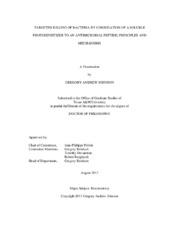| dc.description.abstract | Antimicrobial peptides (AMPs) and photosensitizers (PS) have gained attention as potential alternatives to traditional antibiotics for the treatment of microbial infection due to the decreased likelihood for acquired resistance. However, many AMPs and PS suffer from insufficient activity, specificity, or a combination thereof. AMPs can require high concentrations for effective activity, leading to non-specific side effects and increased costs. PS, on the other hand, are quite active, but are typically hydrophobic and suffer from non-specific binding and damage to host tissues. To solve these problems, we report a novel PS-AMP construct of the soluble PS eosin Y conjugated to the selective AMP (KLAKLAK)_(2). Eosin Y has a high singlet oxygen quantum yield, which is suitable for photodynamic activity, although the solubility of eosin Y results in poor binding and activity toward membranes on its own. On the other hand, the specificity of (KLAKLAK)_(2) is high for an AMP, but could still benefit from enhanced activity at lower concentrations. The killing activity and binding specificity of eosin-(KLAKLAK)_(2) toward both bacteria and mammalian cells was assessed using microbiology, biochemistry, and fluorescence microscopy techniques. Additionally, the mechanism of eosin-(KLAKLAK)_(2) activity was investigated using liposome models to determine factors involved in binding and membrane disruption. Furthermore, novel applications of transmission electron microscopy (TEM) methods were employed to observe the photodynamic effects of eosin-(KLAKLAK)_(2) against bacteria.
The PS-AMP conjugate eosin-(KLAKLAK)_(2) displays synergistic activity between PS and AMP in model liposome systems, and is capable of killing several clinically relevant bacteria, including the multi-drug resistant Acinetobacter baumannii AYE strain. Furthermore, bacterial killing is achieved in the presence of red blood cells (RBCs) and other mammalian cell lines without significant toxicity. Liposome models reveal that the lipid composition of bacteria is a potential factor responsible for the observed binding specificity and corresponding activity. Additionally, TEM methods show that eosin-(KLAKLAK)_(2) causes extensive membrane damage to both Gram positive Staph aureus and Gram negative Escherichia coli, indicating a primary cause of cell death. A model is proposed where the activities of the PS and AMP, respectively, facilitate the activity of one another, leading to enhanced membrane disruption, and effective antibacterial activity while maintaining cell selectivity. | en |


